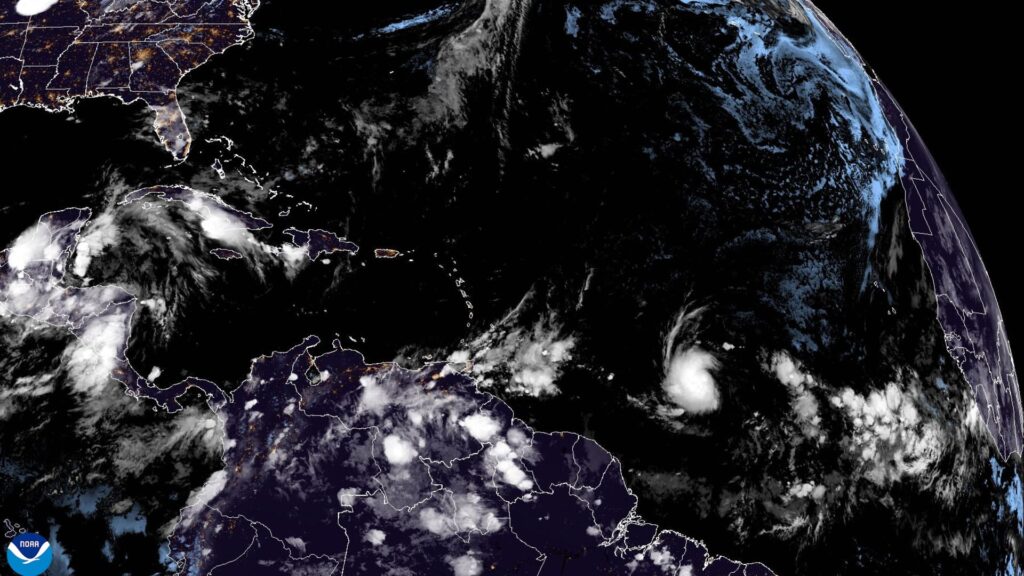Beryl strengthened into a hurricane on Saturday as it barreled toward the southeastern Caribbean, with forecasters warning it was expected to become a dangerously large storm before reaching Barbados late Sunday or early Monday.
A major hurricane is considered a Category 3 or higher, with wind speeds of at least 111 mph (178 km/h). Beryl, a Category 1 hurricane on Saturday afternoon, marked the easternmost hurricane to form in the tropical Atlantic in June, breaking a record set in 1933, said Philip Klotzbach, a hurricane researcher at Colorado State University.
A hurricane warning was issued for Barbados, and a hurricane watch was issued for St. Lucia, Grenada, St. Vincent and the Grenadines. A tropical storm watch has been issued for Martinique, Dominica and Tobago.
“It is astonishing to predict a major (Category 3+) hurricane anywhere in the Atlantic in June, let alone deep in the tropics of the Far East. #Beryl organized quickly over the warmest waters ever recorded in late June, ” Posted by Florida hurricane expert Michael Lowry on X.
Sabu Best, director of the Barbados Meteorological Service, said the beryl center was expected to pass about 26 miles (45 kilometers) south of Barbados. Forecasters then expected the storm to move across the Caribbean Sea toward Jamaica and eventually Mexico.
Late Saturday afternoon, Beryl was located about 720 miles (1,160 kilometers) east-southeast of Barbados, with maximum sustained winds of 75 mph (120 kph). It is moving westward at 22 mph (35 km/h).
“The hurricane is now expected to rapidly intensify,” the Miami-based National Hurricane Center said.
Atmospheric science researcher Tomer Burg noted that Beryl is just a tropical depression with winds of 35 mph on Friday.
“This means that, according to preliminary data, Beryl met the criteria for rapid intensification before it became a hurricane,” he wrote on social media platform X.
Brian McNoldy, a researcher in tropical meteorology at the University of Miami, said warm water fueled the beryl, and ocean heat content in the deep Atlantic reached its highest levels ever recorded for this time of year.
Beryl was also the strongest June tropical storm ever recorded in the far east of the tropical Atlantic, according to Klotzbach.
“We need to be prepared,” Barbados Prime Minister Mia Mottley said in a public address on Friday night. “You and I both know that when these things happen, it’s best to prepare for the worst and hope for the best.”
She pointed out that thousands of people traveled to Barbados to watch the Twenty20 Cricket World Cup final, where India defeated South Africa in the capital Bridgetown on Saturday. It is considered to be the biggest event in cricket.
Some fans, like Shashank Musku, a 33-year-old doctor who lives in Pittsburgh, were eager to change flights and leave before the storm hit.
Masku said by phone that he had never been through a hurricane: “I don’t plan on one either.”
He and his wife, who support India, learned about Beryl through a taxi driver mentioning the storm.
Saint Vincent and the Grenadines Prime Minister Ralph Gonsalves said in a public address on Saturday that shelters would open on Sunday evening and he urged people to be prepared. He ordered officials to refuel government vehicles and asked grocery stores and gas stations to remain open later in the day ahead of the storm.
“If you limit the time, you’re going to get so crowded,” he said, apologizing in advance for the government’s interruption of storm updates from radio stations. “Cricket lovers have to live with the fact that we have to provide information… it’s life and death.”
Beryl is the second named storm expected in the busy Atlantic hurricane season, which runs from June 1 to November 30. Tropical Storm Alberto made landfall in northeastern Mexico earlier this month, bringing heavy rain and killing four people.
Lowry pointed out that in records dating back to 1851, only five named storms have formed in June in the tropical Atlantic east of the Caribbean, and only one of them was a hurricane. He said one of those was the first hurricane in 1933, which was the most active hurricane season ever.
Mark Spence, a hotel manager in Barbados, said by phone that he was calm about the coming storm.
“Tis the season. Storms can happen at any time,” he said. “I’m always prepared. I always have enough food in the house.”
The National Oceanic and Atmospheric Administration predicts that the 2024 hurricane season may be well above average, with 17 to 25 named storms. As many as 13 hurricanes and four major hurricanes are expected.
The Atlantic hurricane season produces an average of 14 named storms, of which 7 are hurricanes and 3 are major hurricanes.
Beryl is expected to bring up to 6 inches (15 centimeters) of rain to Barbados and nearby islands, and a high surf warning with waves up to 13 feet (4 meters) is in effect. Storm surge is expected to reach 7 feet (2 meters).
The storm is approaching the southeastern Caribbean, just days after severe flooding occurred in Port of Spain, the capital of the twin-island nation of Trinidad and Tobago, due to an unrelated weather event.
Caribbean leaders are worried not only about Berrill but also about a series of thunderstorms that will follow in its path and have a 70 percent chance of becoming a tropical depression by the middle of next week.
Meanwhile, an unnamed storm in early June dumped more than 20 inches (50 centimeters) of rain on parts of South Florida, stranding motorists on flooded streets and pushing water into Some houses in low-lying areas.

